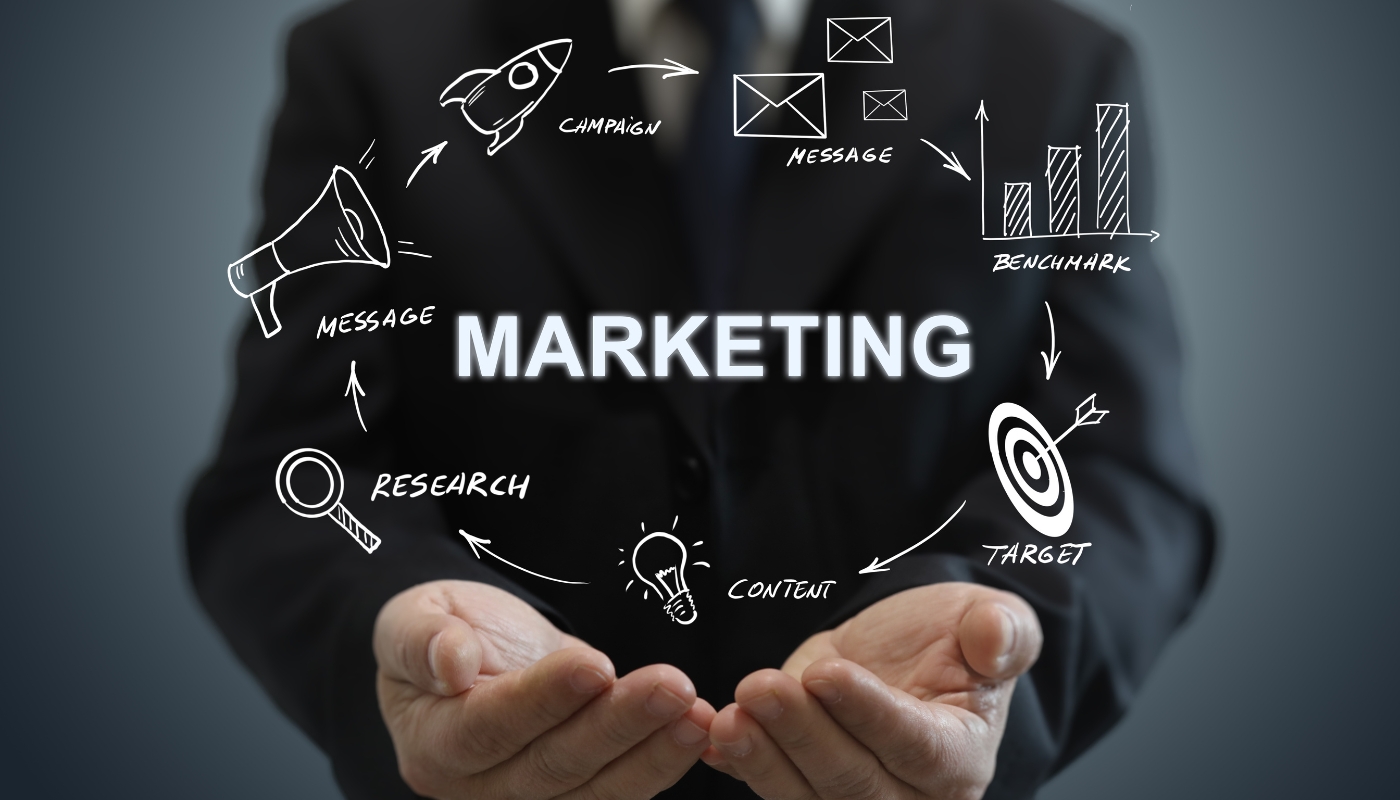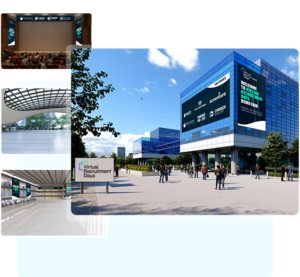A strong marketing plan for virtual events can be the difference between an empty broadcast and a truly unforgettable experience – but where do you start? With so much competition for your audience’s attention, it’s no longer enough to simply announce your event and hope for the best. You need a strategy that connects, excites, and converts.
In this guide, you’ll find a step-by-step approach to crafting a marketing plan that not only brings the right people to your event but keeps them engaged from the very first teaser to the final follow-up.
Ready to make your next virtual event a real success? Let’s dive in!
Step 1: Define Goals and Target Audience in Your Marketing Plan
Before diving into ads, content, and email campaigns, it’s essential to start at the right point: Why are you hosting this virtual event – and who are you hosting it for?
Set Clear Goals in Your Marketing Plan
Begin by setting concrete, measurable goals for your virtual event. Are you looking to:
- Generate leads?
- Build brand awareness?
- Showcase a new product?
- Educate or inspire a specific audience?
Having a clear purpose helps in selecting the right format, content, and communication channels. A lead-generating event, for instance, may require a different tone and registration flow than a brand-building event.
Tip: Use SMART goals to maintain focus throughout the process.
Understand Your Audience For Your Virtual Event
The next step is to identify who you’re targeting. Go beyond demographics and think in terms of:
- What challenges does the audience face?
- Where do they engage online?
- What type of content engages them?
The better you understand your audience, the more effective your communication will be. It’s not just about getting people to sign up – it’s about reaching the right people who will truly benefit from attending.
Tip: If you’ve hosted similar events in the past, leverage data! Analyze past attendees, campaign click rates, and engagement during previous events to fine-tune your strategy.
First-time event? Start by interviewing a few members of your target audience or send out a brief survey via email or social media. Ask what they find most valuable in a virtual event – formats, topics, length, interaction. This will give you insights and help build relationships before you even start promoting the event.
Step 2: Create a Message and Visual Concept in Your Marketing Plan
Once goals and the target audience are defined, the next step is to craft a communication concept that stands out. Your event doesn’t just compete with other events – it competes with everything else grabbing attention in the feed.
A Virtual Event with a Clear Value
Why should someone attend your event? The answer should permeate all your communication.
- What will participants learn, experience, or take away?
- What problem are you helping them solve?
- How is this event different from others?
Summarize this into a core message that’s easy to understand and share – preferably in one or two sentences. Avoid fluffy language and be concrete.
Example: “Learn how to double your digital campaign conversions – directly from industry-leading experts.”
Develop a Consistent Visual Identity in Your Marketing Plan
The visuals are a crucial part of your brand’s impression – and that’s true for virtual events as well. Create a simple yet consistent graphic concept that works across all channels:
- Colors, typography, and logo
- Icons, photos, or illustrations
- Event title and tagline
- Layout for landing pages, emails, ads, and social media
Consider using a design platform that makes it easy to reuse and adapt graphics for different formats and channels.
Tip: Think mobile-first! Much of your communication will reach your audience via mobile—ensure graphics, CTA buttons, and text look great on smaller screens.
Create an Engaging Landing Page for Your Virtual Event
Your event website or landing page is often the first real point of contact with participants. It should be both informative and optimized for conversion:
- A clear and engaging headline
- A brief description of the purpose and value
- Speaker profiles, agenda, dates, and times
- Call to action (registration, “add to calendar”, share event features)
Bonus: Add a short video with a greeting from the keynote speaker, a sneak peek from previous events, or an animated walkthrough of what’s to come.
Step 3: Choose the Right Channels and Plan Content for Your Virtual Event
Now that your message and visual concept are in place, it’s time to think about how and where to promote the event – and what to say along the way. An effective channel strategy isn’t about being everywhere, but about being where it counts.
Identify the Right Marketing Channels
Start with where your audience engages online – and how they consume information. Choose channels based on your goals, budget, and audience behavior.
Examples of channels include:
- Email marketing: Perfect for direct communication with leads and past participants.
- Social media: LinkedIn for B2B, Instagram and Facebook for broader audiences.
- Paid advertising: Google Ads, Meta ads, or sponsored content in industry media.
- Partners and speakers: Leverage their networks for extra exposure.
Tip: Create ready-made resources for your partners and speakers – such as graphic templates and text suggestions. This makes it easier for them to spread the word about your event.
Build a Content Plan for Your Virtual Event
Think long-term and plan communications across several phases. A common mistake is starting the promotion too late or only pushing the registration link.
A good content journey could look like this:
- Teasers and save-the-date: Build anticipation early.
- Value-driven content: Introduce speakers, topics, and formats. Share short articles, quotes, or video clips.
- Reminders and countdowns: Ramp up intensity as the event approaches.
- Behind the scenes or Q&A: Make it personal – show who’s behind the event.
Tip: Use a simple content calendar tool to keep track of publishing dates, channels, and responsibilities.
A Marketing Plan that Adapt Content to the Channel
The same message can be packaged in different ways. A LinkedIn post can be more professional and data-driven, while an Instagram post might be more visual and emotional. Consider the tone, length, format, and audience of each channel.
Need inspiration? Check out how others in your industry market similar events and take note of the formats that get the most engagement.

Step 4: Engage Participants Before the Event – Marketing Plan
Registration is just the beginning. To ensure participants actually show up – and are active when they are – it’s crucial to build engagement before the event starts. The goal is to create anticipation, curiosity, and a sense that something exciting is coming.
Create a Pre-event Communication Flow for Your Virtual Event
Plan a series of emails or automated reminders that keep participants warm from registration to the event’s start.
Examples of content you could send:
- Confirmation + “add to calendar” link
- A brief greeting from a speaker
- Tips for how participants can prepare
- Countdown with program highlights
- Bonus materials (e.g., relevant report, quiz, or preview)
Tip: Be clear about what participants will gain – each email should remind them why the event is relevant to them.
Early Engagement Tactics for Your Virtual Event Marketing Plan
With a good marketing plan, you can early engage your participants. The earlier you activate participants, the more likely they are to log in on the day and engage actively.
Ways to create early engagement:
- Start a discussion in social media or a community forum
- Ask participants to submit questions for the panel in advance
- Create a hashtag and encourage sharing
- Host a short pre-event live stream, AMA, or teaser Q&A
Tip: Create a digital forum – such as a dedicated Slack channel, LinkedIn group, or a social media community space. Encourage participants to introduce themselves, share expectations, or ask questions before the event. This fosters a sense of belonging and encourages activity without requiring real-time participation.
Gamification & Exclusive Content in Your Marketing Plan
Engagement can also be driven through small incentives. Offer something extra to those who engage early:
- Early access to a PDF guide or bonus video
- A points system or badges for activity on the platform
- Contests (e.g., “best question wins a prize”)
Example: “Sign up before [date] and gain exclusive access to our whitepaper + a chance to win a free consultation.”
Step 5: A Marketing Plan for Your Virtual Event to Maximize Engagement During the Event
It’s showtime! But just “broadcasting” an event isn’t enough. To ensure participants feel involved and get maximum value, you need to create interaction, energy, and movement throughout the event. Therefor are a marketing plan just as important now, during your virtual event.
Activate Participants Immediately with Your Marketing Plan
Start the event with energy – such as a live host, an inspiring keynote, or a quick icebreaker activity. Set the tone that this isn’t a passive webinar, but an experience where participants are expected to engage.
Ways to create immediate engagement:
- Quick poll or survey at the start
- A chat thread for introductions: “Where are you tuning in from + what are you most looking forward to?”
- A welcome video or live greeting
Tip: An engaging moderator makes a huge difference – both for keeping the pace and for capturing questions, reactions, and comments in real time.
Create Interactive Moments at Your Virtual Event
Help speakers and panels plan brief pauses for:
- Live polls
- Mentimeter questions or Kahoot quizzes
- Chat discussions with open questions
- Breakout rooms for group conversations
- Raise hand or emoji reactions
Tip: Prepare interactions in advance – integrate them into the script or event schedule to ensure they’re not forgotten during presentations. Interaction should be part of the content, not an add-on.
Use Gamification or Incentives
The small details in your marketing plan for your virtual event can make a huge difference. For example, keep participants’ attention with small rewards and activities throughout the event:
- Points system: collect points for each activity
- Digital “bingo cards” to encourage participation
- Prize draws for the most active participants
- A leaderboard that updates live
Example: “The five participants who ask the most questions in the chat win an exclusive package from our partners!”

Step 6: A Marketing Plan with an End – Follow Up and Repurpose Content
Your Marketing plan for your virtual event shouldn’t be over when the event is. Once the event is over, it’s easy to think the work is finished. But to maximize the value of your virtual event, you need to follow up with participants and repurpose the content strategically.
Send a Thank-You Email and Summary after Your Virtual Event
Start by thanking participants for their time and engagement. A personal message leaves a positive impression and builds a long-term relationship. But it’s also important to remind them of what they gained from the event:
- A link to the event’s recorded sessions
- Highlights and key takeaways
- Links to relevant additional content (articles, e-books, guides)
Tip: Send the email immediately after the event to keep engagement high. Reminding participants of key points helps reinforce your message.
Analyze and Evaluate Results from Your Virtual Event
It’s time to look at the data you gathered during the event and analyze what worked – and what can be improved.
Key metrics to review:
- Participant growth and registrations
- Engagement in chat and during interactive moments
- Feedback from surveys and evaluations
- Conversion rate (e.g., number of leads, sign-ups, or sales)
Tip: Look at both quantitative and qualitative data. How many registered? How many were active during the event? What was the general sentiment after the event?
Repurpose Content for Your Next Marketing Plan
To get even more value from your virtual event, repurpose and distribute the content in various ways. This way you’ll be ready for your next virtual event, and you can make an even better marketing plan.
- Social Media: Cut highlights or quotes from speakers to create shareable video clips.
- Blog Posts & Articles: Summarize the most valuable insights from the event and publish them on your blog or other channels.
- On-demand Content: Make event recordings available for those who couldn’t attend live, and use this as a lead magnet to collect contact details.
Tip: A simple “best of” video with quotes, images, and clips from speakers can be a great way to keep the interest alive after the event.
Continue Engaging Participants After the Virtual Event
A follow-up shouldn’t just be about saying thank you. Give participants a reason to stay connected and continue engaging with your brand.
- Offer exclusive deals or early access to upcoming events
- Start a conversation on social media or in a group
- Request feedback and gather ideas for future events
Tip: Use the follow-up email as an opportunity to nurture the relationship. Suggest relevant blogs or courses to help participants deepen their knowledge.
Conclusion: Maximizing Success for Your Virtual Events with a Marketing Plan
Creating a marketing plan for a virtual event takes time, engagement, and follow-up – but by following these six steps, you can maximize your chances of success and build long-term relationships with your participants. From setting clear goals to smartly repurposing content after the event, you now have a structured path to fully harness the potential of your virtual events.
Take the first step toward your next successful virtual event with a well thought out marketing plan. You can also read our Free Guide for more insights into marketing connected to virtual events.
Want to learn more about virtual events? Download our free guides for more tips and strategies or explore more blog posts covering everything from platform selection to creating the ultimate event experience.






